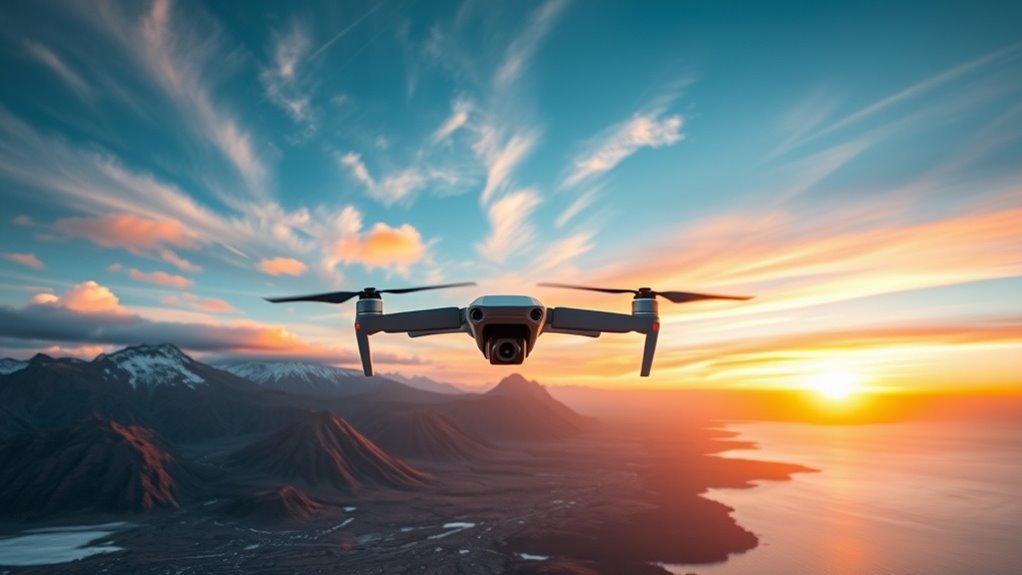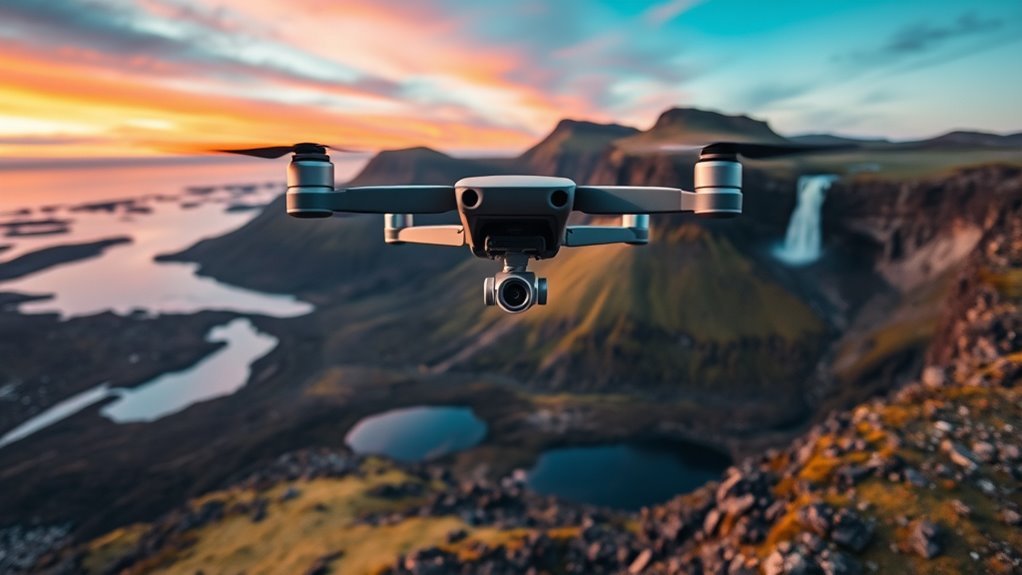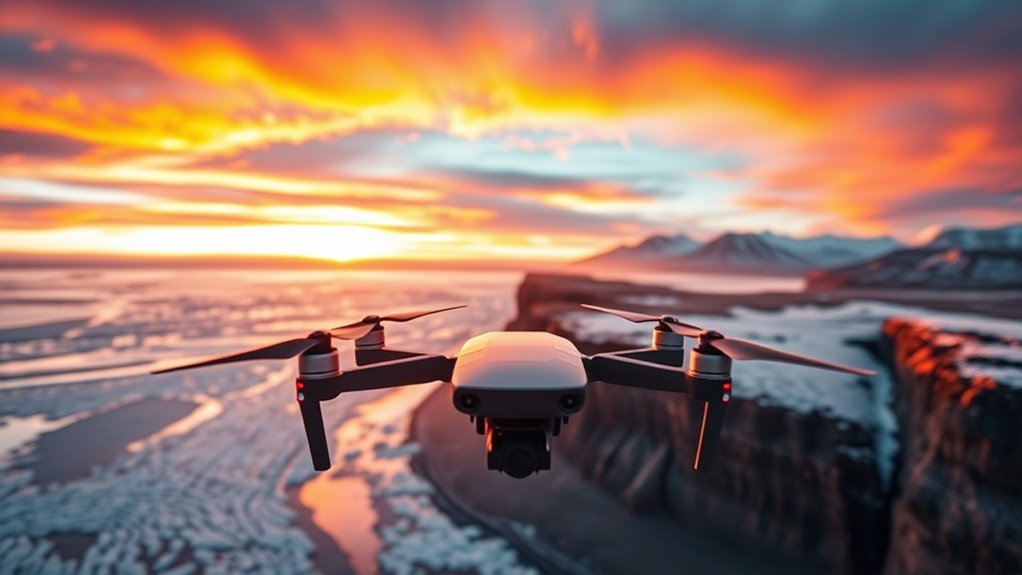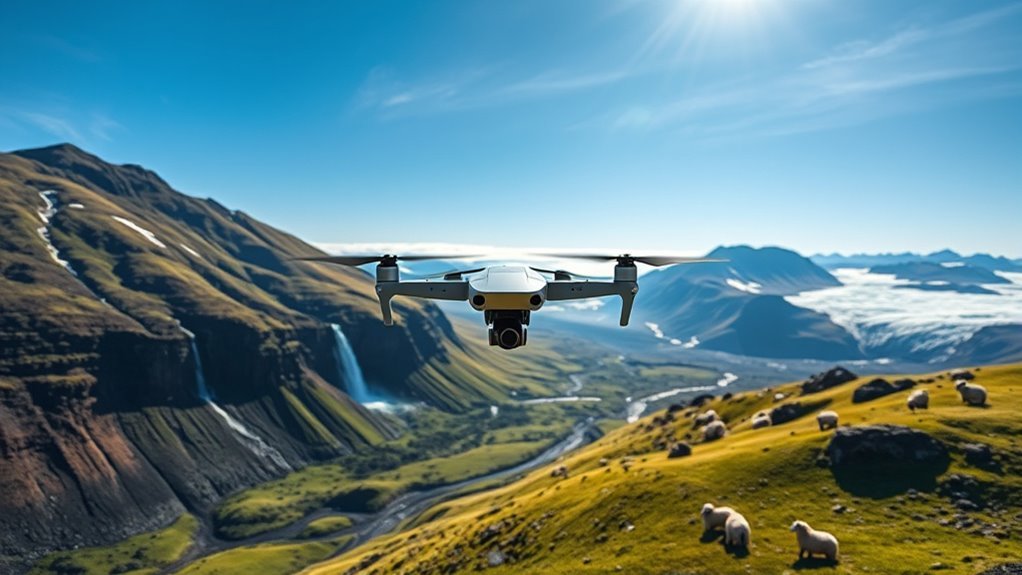To fly a drone in Iceland, you must register it with the Icelandic Transport Authority and obtain the required license if over 250 grams. Adhere to a maximum altitude of 120 meters and maintain visual line of sight. Avoid restricted zones near airports, military sites, and national parks. Respect privacy laws and environmental protections to prevent fines or legal issues. Following these basics guarantees compliance and safety—keep exploring to understand detailed flight rules and responsible practices.
Understanding Icelandic Drone Laws

Although drone use in Iceland offers unique opportunities for aerial photography and research, you must adhere to specific regulations set by the Icelandic Transport Authority. These rules guarantee safe, responsible drone operation while respecting privacy and environmental concerns. You’re required to maintain visual line of sight, avoid flying above 120 meters, and stay clear of restricted zones like airports and nature reserves. Drone insurance is mandatory for commercial use, providing financial protection against potential damages or accidents. When capturing aerial photography, you must prioritize public safety and privacy, avoiding flights over crowds or private property without consent. Complying with these regulations lets you explore Iceland’s landscapes freely yet responsibly, balancing your adventurous spirit with the legal framework designed to protect everyone’s interests.
Registering Your Drone in Iceland

Since drone operations in Iceland are regulated to guarantee safety and accountability, registering your drone with the Icelandic Transport Authority is a mandatory step before flying. The drone registration process is streamlined but requires you to submit specific required documentation, including proof of ownership and technical specifications of your drone. You must complete the online registration form accurately to ascertain compliance. Once registered, you’ll receive a unique identification number that must be visibly affixed to your drone. This procedure not only legitimizes your operation but also enables authorities to maintain oversight, enhancing safety for all airspace users. By completing the registration swiftly, you secure your freedom to explore Iceland’s skies legally and responsibly within the established regulatory framework.
Age and License Requirements for Drone Pilots

When operating a drone in Iceland, you’ll need to meet specific age and licensing requirements designed to guarantee safe and responsible piloting. The Civil Aviation Authority enforces strict age restrictions: pilots must be at least 15 years old to operate drones over 250 grams. For younger enthusiasts, drones under 250 grams are generally exempt from licensing but still require adherence to safety guidelines.
Regarding license types, Iceland distinguishes between basic and advanced drone pilot licenses. The basic license covers operations within visual line of sight under 120 meters altitude, while the advanced license permits more complex flights, including beyond visual line of sight and higher altitudes, subject to additional training and testing. Ensuring you possess the correct license type for your flight scenario is essential for legal and unrestricted drone use in Iceland.
Drone Flight Restrictions and No-Fly Zones
When flying drones in Iceland, you must avoid restricted airspace areas designated for safety or security reasons. National parks enforce strict no-fly zones to protect wildlife and natural landscapes, so you’ll need to respect these boundaries. Additionally, urban flight is limited to prevent interference with populated areas and infrastructure.
Restricted Airspace Areas
Although drone technology offers impressive capabilities, you’ll need to navigate Iceland’s restricted airspace carefully to confirm compliance with local regulations. Iceland’s airspace is divided into specific classifications, each with corresponding flight restrictions that apply to drone operators. Restricted zones typically include areas near airports, military installations, and vital infrastructure where drone flights are prohibited or require special authorization. Understanding these airspace classifications is essential to maintain legal and safe operations while maximizing your freedom to explore. You should always consult the latest aeronautical charts and official notices to identify restricted zones before flying. Ignoring these regulations can result in fines or confiscation of your drone, so staying informed guarantees you can enjoy aerial freedom responsibly within Iceland’s precise airspace framework.
National Parks No-Fly Zones
Since national parks in Iceland protect sensitive ecosystems and wildlife habitats, drone flights are strictly regulated or prohibited within their boundaries. You must respect these no-fly zones to minimize your drone tourism impact, which can disturb wildlife and damage fragile environments. Icelandic authorities enforce these restrictions rigorously, so you’re required to stay clear of national park boundaries unless you obtain specific permits. Even if you seek freedom in flight, operating drones inside or near these protected areas without authorization is illegal and can lead to penalties. To guarantee compliance, consult official maps highlighting national park boundaries before planning your drone activities. By adhering to these regulations, you help preserve Iceland’s pristine natural heritage while responsibly enjoying your drone experience.
Urban Flight Limitations
Because urban areas in Iceland have dense populations and critical infrastructure, drone operations face strict restrictions to secure public safety and privacy. When flying near urban infrastructure, you must avoid congested zones, maintain line-of-sight, and comply with altitude limits typically capped at 50 meters. Unauthorized flights over sensitive sites, such as government buildings, hospitals, and transportation hubs, are prohibited. If your goal is aerial photography, you’ll need prior approval from municipal authorities, especially in Reykjavik. Additionally, no-fly zones extend over schools and crowded public events to minimize privacy violations and security risks. To operate freely, always check updated maps and local regulations before launching your drone. Adhering to these urban flight limitations guarantees your compliance while preserving the freedom to capture Iceland’s cityscapes safely.
Maximum Altitude and Distance Limits
When flying drones in Iceland, you must adhere to strict altitude and distance limits set by aviation authorities to guarantee safety and compliance. The maximum altitude for unmanned aerial vehicles is capped at 120 meters (approximately 394 feet) above ground level to prevent interference with manned aircraft operations. Distance limits require you to keep your drone within visual line of sight (VLOS) at all times, generally not exceeding 500 meters horizontally. These parameters assure you maintain control and avoid restricted airspaces. Exceeding these limits can lead to penalties and compromise safety. While these rules impose boundaries, they also provide a framework that balances your freedom to explore Iceland’s stunning landscapes responsibly and legally, allowing for secure, enjoyable drone flights without endangering others or breaching regulations.
Privacy and Safety Considerations
Although drone technology offers unprecedented aerial perspectives, you must prioritize privacy and safety considerations to operate responsibly in Iceland. Respecting personal privacy is essential; avoid capturing images or videos of individuals without explicit consent, as this infringes on legally protected rights. Moreover, be aware of restricted zones where drone use may compromise public safety, such as near emergency response activities or crowded outdoor events. Maintain visual line of sight with your drone at all times to prevent collisions and maintain control. In addition, avoid flying over private properties without permission to prevent privacy violations and potential legal repercussions. By adhering to these guidelines, you uphold both personal privacy and public safety, enabling you to enjoy your drone flights freely while complying with Icelandic regulations.
Flying Near Airports and Urban Areas
If you’re planning to fly drones near airports or urban areas in Iceland, you must strictly adhere to specific regulations designed to secure airspace safety and minimize risks to people and property. Maintaining careful airport proximity awareness is essential—drones must stay at least 2 kilometers from any airport boundary. Urban awareness is equally important; flying over crowds or densely populated areas is prohibited without special permission to protect public safety.
Remember these key points:
- Respect no-fly zones around all airports.
- Avoid flying above gatherings or urban centers.
- Keep your drone within visual line of sight at all times.
- Obtain necessary permits for any operations near restricted zones.
Following these rules guarantees freedom to explore Iceland’s skies responsibly and safely.
Environmental Protection and Wildlife Guidelines
Because Iceland’s unique ecosystems are particularly sensitive, you must follow strict environmental protection and wildlife guidelines when flying drones. Prioritize wildlife protection by maintaining minimum distances from animals and nesting sites to avoid disturbance. Your drone’s noise and presence can cause stress, altering natural behaviors and increasing environmental impact. Avoid flying in protected areas without explicit permission, as these zones enforce heightened restrictions to preserve biodiversity. Monitor weather and terrain to prevent unintended crashes, which could damage fragile habitats. By adhering to these protocols, you not only respect Iceland’s ecological integrity but also secure your freedom to explore its landscapes responsibly. Always check updated local regulations before each flight to guarantee compliance with environmental standards, balancing your drone activities with the imperative of conservation.
Penalties for Violating Drone Regulations
Respecting environmental protection and wildlife guidelines is not just about preserving Iceland’s natural heritage; it’s also about staying within the legal framework set for drone operations. If you violate these regulations, you risk facing significant fines and penalties enforced by Icelandic authorities. Enforcement actions aren’t taken lightly, especially when drones endanger protected areas or disturb wildlife.
Potential consequences include:
- Monetary fines that can severely limit your flying freedom
- Confiscation of your drone equipment
- Legal proceedings that could restrict future drone use
- Potential criminal charges for serious breaches
Understanding these penalties emphasizes the importance of compliance. Staying informed guarantees you enjoy your flights without legal interruptions, preserving both your freedom and Iceland’s pristine environment.
Tips for Responsible and Enjoyable Drone Flying in Iceland
When flying drones in Iceland, you’ll want to prioritize safety, legal compliance, and environmental mindfulness to guarantee a smooth experience. Always check local weather conditions and respect no-fly zones, especially near airports and protected areas. Before launching, verify your drone’s firmware is updated and conduct pre-flight checks to avoid technical failures. Choose scenic locations with open spaces, minimizing disturbance to wildlife and crowds, which enhances your drone photography outcomes. Maintain visual line of sight and fly below 120 meters to comply with regulations. Avoid flying over people or private property without permission to respect privacy laws. Finally, store your flight logs and stay informed about any regulatory changes to ensure ongoing compliance while enjoying the freedom to capture Iceland’s breathtaking landscapes responsibly.

